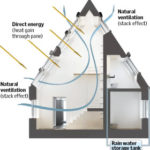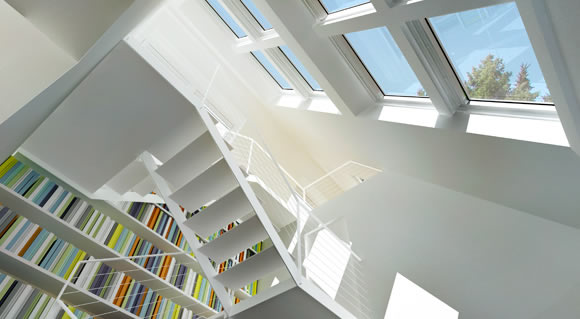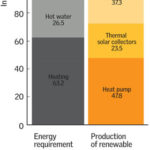LichtAktiv Haus
Our future homes need to provide healthier, more comfortable living environments – without negatively impacting our climate. LichtAktiv Haus offers a high standard of living full of fresh air and daylight while covering its entire energy demand, including electricity, through renewable energy.
This is a particular challenge when renovating older homes as they often have much higher energy demands.
During the winter, passive solar heat gain through the roof windows reduces the need for heating, while shutters and blinds help prevent overheating in the summer. The windows combine optimum solar gain transmittance (g-value) and thermal transmittance (U-value), and they face the sun in order to reduce the use of artificial light.
An air-water-heat pump and 22.5 m² of solar collectors work together to supply the home with heating and hot water. This highly-efficient technology reduces greenhouse gas emissions by minimising the need for conventional energy. The home’s 75 m² of polycrystalline photovoltaic cells on the roof power the heat pump and also act as a source of environmentally friendly electricity.
The many windows in LichtAktiv Haus have shutters and blinds to ensure a comfortable indoor climate at all times. During the summer, south-facing shutters shield the house from the sun in the afternoon. And on the building’s western side, external awning blinds lower automatically in the afternoon. In the evening, the shutters and blinds are raised again to let in the fresh, cool air. In the colder months, the shutters stay up to allow passive solar heat to warm the home, and at dusk the shutters close to keep the heat inside.
Sunlight not only influences our internal clocks, it also has a positive impact on our health and well-being. And bringing more daylight into a home can significantly decrease its energy consumption by reducing the need for artificial lighting.
To plan the distribution of daylight in LichtAktiv Haus, a team led by light designer and professor Peter Andres made daylight analyses using the daylight factor (DF) performance indicator. The team placed windows and sun tunnels in spots that would maximise daylight in the home and provide generous views, thus allowing the family to experience natural daily rhythms and seasonal changes. The kitchen, dining areas and bedrooms in LichtAktiv Haus have an average DF of five percent or more, and the living area has an average DF of over 10 percent. This means that no electric lighting is needed during a typical day.
To provide the family with a flexible, comfortable environment, the amount of incoming daylight can be adjusted by awning blinds. Not only do they prevent glare and overheating, they also help create the right atmosphere in the rooms.
Automatically-controlled roof windows in LichtAktiv Haus eliminate the need for a ventilation shaft. Depending on the temperature, CO2 concentration and level of humidity in the home, a solar-powered control system automatically opens and closes the windows to ensure a comfortable, healthy indoor climate at all times. The system is most effective when several façade and roof windows are opened at the same time. Because the windows are located at varying heights, the ‘chimney effect’ allows warm, stale air to escape through the roof windows, while fresh air flows in through the lower façade windows.
Along with water-saving fixtures throughout the house, LichtAktiv Haus also features water collectors that supply rain water for the washing machine, garden watering and toilets
LichtAktiv Haus transformed a box-like, closed structure into an open group of spacious rooms flooded with natural light. The old building now has two children’s rooms, two bathrooms, a master bedroom, a central living area and a reading room. All rooms feature façade and roof windows that are positioned to ensure optimum distribution of natural light – and the home’s window area was increased from 18 m² to 60 m². The living area also now has a five-metre-long glass wall that opens out to the home’s garden. A new extension contains an open living and dining room, a kitchen and a utility room. A porch connects this new section of LichtAktiv Haus with the old home and also serves as the main entrance. In order to cover all the energy demands of the house withclean, renewable energy, the extension’s roof is packed with solar collectors for hot water, and photovoltaic solar cells for electricity. The concept of LichtAktiv Haus was based on the “settler spirit”, but instead of self-sufficiency in terms of food, the home is self-sufficient in terms of energy. The LichtAktiv Haus can be realised in different variants. A basic modernisation and in modules, where elements from the full proposal are used, according to financial ability, energetic ambition and need for extension square metres. The work on the final design of the modular system is still in progress.






